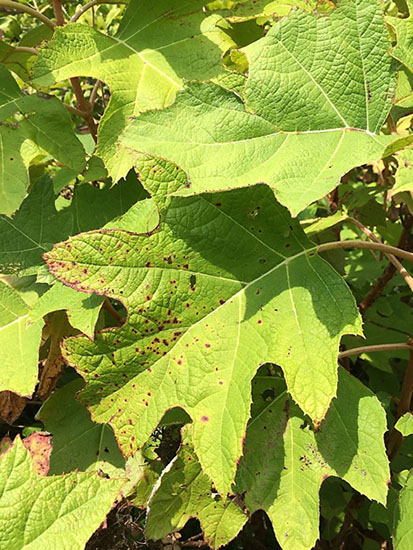Issue 15, August 31, 2015
Bacterial Leaf Spot on Oakleaf Hydrangea
Hydrangeas are known hosts to several leaf spots, both fungal and bacterial. Oakleaf Hydrangeas, in particular, are known to develop leaf spots caused by the bacterial pathogen Xanthomonas campestris.

Bacterial Leaf Spot (Xanthomonas campestris) on Oakleaf Hydrangea
Bacterial leaf spot on hydrangea overwinters in diseased plant debris. The pathogen moves to developing plant tissues by splashing water from rain or irrigation. Once in contact with the host, the bacteria enter the plant through stomata, other natural openings, and/or plant wounds. Symptoms of infection first appear on lower leaves as water-soaked spots that eventually darken to a reddish-purple color and develop an angular shape. Multiple spots may enlarge, coalesce and cause death to mature leaves. Disease development is favored by warm, wet conditions which allow for increased bacterial production and dissemination. Overhead irrigation and close plantings extend the amount of time leaves remain wet and favor disease development.
Cultural disease control options should be your first course of action.
- Remove diseased debris from the site. Debris harbors the bacteria and provides inoculum for future infections. Infected debris should be burned, buried or discarded. On-site composting is not advised.
- Monitor the plants closely during the growing season. Leaves displaying leaf spot symptoms should be removed from the plant and site.
- Avoid pruning or working near problematic plants when they are wet. These activities will likely spread the pathogen as well as create wounds and entry points. Disinfecting your pruners between cuts will further help reduce the spread of the pathogen.
- Avoid overhead irrigation and wetting the foliage. If unavoidable, irrigate at a time of day that minimizes the duration of leaf wetness. Adequate plant spacing will also help limit the duration of leaf wetness.
Pesticides containing copper sulfate and copper octanoate (copper soap) are broadly labeled for control of leaf spots on ornamentals, but are only marginally effective. They should be applied preventatively or at first sign of disease. Use products containing copper with caution as they may cause phytotoxicity. (Travis Cleveland)
Author:
Travis Cleveland